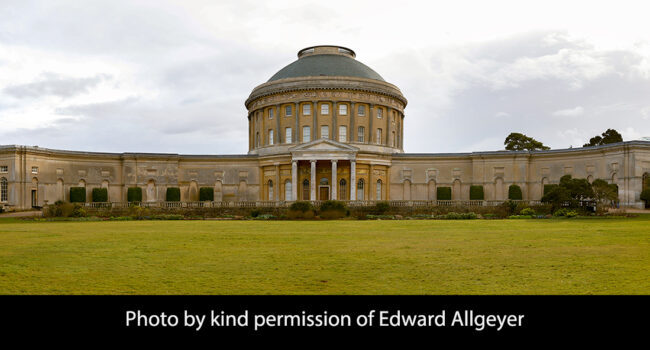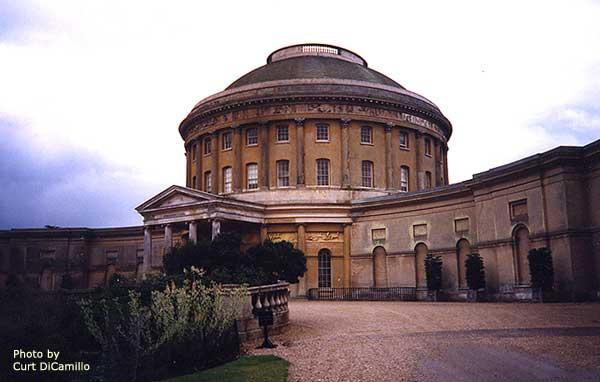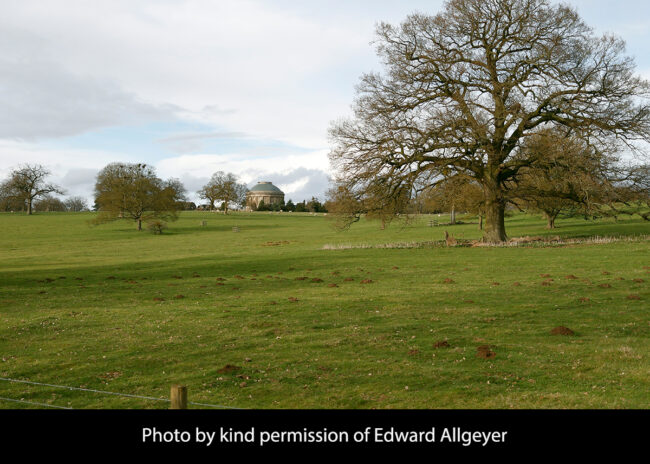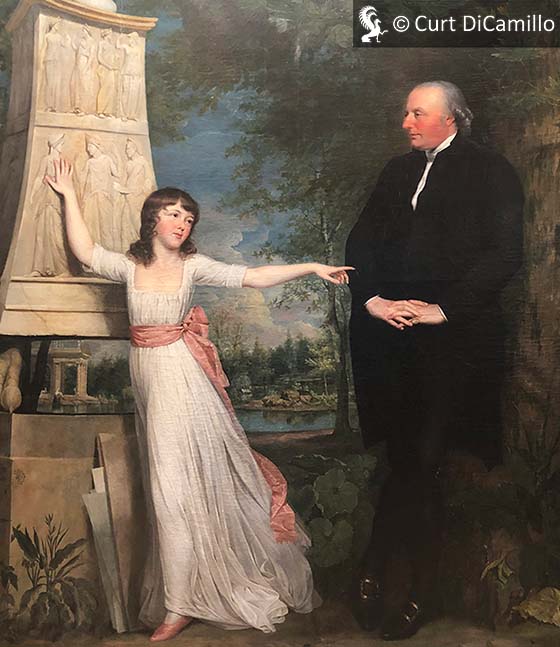
The entrance facade

The entrance facade

The house from the park

This circa 1790 painting by Hugh Douglas Hamilton, today in the collection of the National Gallery of Ireland, shows the builder of Ickworth, Frederick Hervey, Bishop of Derry and 4th Earl of Bristol, with his granddaughter, Lady Caroline Crichton, in the gardens of the Villa Borghese in Rome.
Earlier Houses: There was at least one earlier house on, or near, the site of the current house.
Built / Designed For: 4th Earl of Bristol and Bishop of Derry
House & Family History: Beginning in 1796 the eccentric Frederick Augustus Hervey (1730-1803), the famous earl-bishop (4th Earl of Bristol and Bishop of Derry), began to build Ickworth, his equally eccentric house. Made of stuccoed brick, the front façade of Ickworth House is over 600 feet long, with the focal point being the 100-foot-high elliptical rotunda, connected by quadrants to pavilions, the latter not completed until circa 1830, when they were finished for the 5th Earl of Bristol, later 1st Marquess of Bristol. The west wing remained uncompleted until 2006, when a joint partnership between the National Trust and Sodexho Prestige resulted in its renovation and opening as a venue for events and conferences. The idea for the rotunda was probably the earl-bishop's and was very likely based on John Plaw's design for Belle Isle on Lake Windermere, which was itself based on the designs of the Italian architect Mario Asprucci. In 1796 the earl-bishop wrote "I flatter myself that my architectural ideas are Pure and Noble. I wish to make it quite classical, to unite magnificence with convenience and simplicity with Dignity—no redundancy—no superfluity—no one unnecessary room, but the necessary ones to be noble and convenient." Circa 1787 the earl-bishop began building an Irish house in Co. Londonderry named Ballyscullion to the same design ultimately implemented at Ickworth (Ballyscullion was never finished and nothing remains of it today). The earl-bishop was a great collector of paintings and marbles, an inveterate traveler (Bristol hotels, famous on the continent, were named after him), and a lover of Italy (he died there in 1803 in the outhouse of a peasant's cottage near Rome because the owner didn't want a Protestant heretic to die under his roof). The National Trust acquired the Ickworth Estate in the 1956 when the 4th Marquess of Bristol (1863–1951) handed over the estate, together with a significant endowment, in lieu of death duties (the British Treasury took much of the contents, also in lieu of death duties, around the same time). As part of the agreement of transfer to the National Trust, a 99-year lease on the 60-room east wing (the family wing) was granted to the 4th Marquess, with the stipulation that accommodation should always be available for the head of the Hervey family at Ickworth. However, in 1998 the 7th Marquess of Bristol (1954–99) sold the lease on the east wing to the National Trust. This was done partly for financial reasons, partly because of Lord Bristol's out-of-control drug use, and partly in response to an eviction lawsuit resulting from his behavior on the estate (he liked to run-down visitors in his Bentley). The 7th Marquess was dubbed a "wastrel" by the "Oxford Dictionary of National Biography." He appeared frequently in the British tabloids for his wild parties, drug use (he served two terms in prison for drug violations), and homosexuality (he claimed to have used over 2,000 male prostitutes). In 1970, when he was 16, the future Lord Bristol inherited £1 million, topped off by a further £4 million five years later; he managed this money astutely, possessing a net worth of approximately £35 million at its height. By the time of his death at the age of 44, he had lost everything; his estate was probated for £5,000. In July 2002 the east wing was opened as the Ickworth Hotel and Apartments, with a 27-bedroom hotel in the east wing and apartments in the Dower House. Lord Hervey, the noted writer and diarist, was the son of the 1st Earl of Bristol. The Hervey family was seated at Ickworth from the 15th century until 1998, when the 7th Marquess vacated the house.
Collections: Ickworth contains an exceptional collection of paintings, including works by Titian, Claude, Poussin, and Velázquez, as well as an incomparable series of 18th century family portraits by Hogarth, Batoni, Gainsborough, Reynolds, Angelica Kauffmann, Vigee-Lebrun, Ramsay, and Van Loo. The house contains one of the finest collections of Georgian silver in Britain, as well as excellent Regency porcelain and furniture. Canova designed the Ickworth library fireplaces for the earl-bishop. Jakob Philip Hackert's pair of "Classical Landscapes," dated 1779 and 1780, purchased by the earl-bishop, were sold in 1987 for £900,000 to a Swiss buyer. Sotheby's sold some contents, originally at Ickworth (sold from Little Horringer Hall), September 14-16, 1999.
Garden & Outbuildings: An Italianate garden, to the south of the house, is set in a Capability Brown park with woodland walks, a deer enclosure, a vineyard, a Georgian summer house, a canal, and a lake.
Chapel & Church: Members of the Hervey family, from Thomas Hervey (died 1467) to the 7th Marquess of Bristol (died 1999), have been buried at St. Mary's Church, also known as Ickworth Church. Located in the park, the Norman church (with later additions) features a 15th century wall painting of the Angel of the Annunciation, roundels of 14th century Flemish glass, and a 15th-century font. The church is still owned by the Hervey family and is derelict, though the recent formation of the Ickworth Church Conservation Trust is a reason for hope for the church's restoration.
Architect: Francis Sandys
Date: 1796Architect: Unknown (designed by an unknown architect)
Date: Circa 1825-30Architect: Frederick Augustus Hervey (Bristol)
Date: 18th centuryJohn Bernard (J.B.) Burke, published under the title of A Visitation of the Seats and Arms of the Noblemen and Gentlemen of Great Britain and Ireland, among other titles: Vol. I, p. 78, 1852.
Country Life: LVIII, 668, 698, 1925. CXVIII, 678, 1955. CLIII, 1362, 1973.
Title: Houses of Ireland: Domestic Architecture from the Medieval Castle to the Edwardian Villa, The
Author: de Breffny, Brian; ffolliott, Rosemary; Mott, George
Year Published: 1975
Reference: pgs. 166-168
Publisher: New York: Viking Press
ISBN: 670381020
Book Type: Hardback
Title: Biographical Dictionary of British Architects, 1600-1840, A - SOFTBACK
Author: Colvin, Howard
Year Published: 1995
Reference: pgs. 848, 849
Publisher: New Haven: Yale University Press
ISBN: 0300072074
Book Type: Softback
Title: Disintegration of a Heritage: Country Houses and their Collections, 1979-1992, The
Author: Sayer, Michael
Year Published: 1993
Publisher: Norfolk: Michael Russell (Publishing)
ISBN: 0859551970
Book Type: Hardback
Title: Burke's & Savills Guide to Country Houses, Volume III: East Anglia
Author: Kenworthy-Browne, John; Reid, Peter; Sayer, Michael; Watkin, David
Year Published: 1981
Publisher: London: Burke's Peerage
ISBN: 0850110351
Book Type: Hardback
House Listed: Grade I
Park Listed: Grade II*
Past Seat / Home of: SEATED AT EARLIER HOUSES: John Hervey, 1st Earl of Bristol and 1st Baron Hervey, 1700-51; George William Hervey, 2nd Earl of Bristol and (de jure) 2nd Baron Hervey, 1751-75; Augustus John Hervey, 3rd Earl of Bristol and 3rd Baron Hervey, 1775-79. SEATED AT CURRENT HOUSE: Frederick Augustus Hervey, 4th Earl of Bristol, 4th Baron Hervey, 5th Baron Howard de Walden, and Bishop of Derry, until 1803; Frederick William Hervey, 1st Marquess of Bristol, 5th Earl of Bristol, 1st Earl Jermyn, and 5th Baron Hervey, 1803-59; Frederick William Hervey, 2nd Marquess of Bristol, 6th Earl of Bristol, 2nd Earl Jermyn, and 6th Baron Hervey, 1859-64; Frederick William John Hervey, 3rd Marquess of Bristol, 7th Earl of Bristol, 3rd Earl Jermyn, and 7th Baron Hervey, 1864-1907; Frederick William Fane Hervey, 4th Marquess of Bristol, 8th Earl of Bristol, 4th Earl Jermy, and 8th Baron Hervey, 1907-51; Herbert Arthur Robert Hervey, 5th Marquess of Bristol, 9th Earl of Bristol, 5th Earl Jermyn, and 9th Baron Hervey, 1951-60; Victor Frederick Cochrane Hervey, 6th Marquess of Bristol, 10th Earl of Bristol, 6th Earl Jermyn, and 10th Baron Hervey, 1960-85; Frederick William John Augustus Hervey, 7th Marquess of Bristol, 11th Earl of Bristol, 7th Earl Jermyn, and 11th Baron Hervey, 1985-98; Hervey family here from the 15th century until 1998.
Current Ownership Type: The National Trust
Primary Current Ownership Use: Visitor Attraction
House Open to Public: Yes
Phone: 01284-735-270
Fax: 01284-735-175
Email: [email protected]
Website: https://www.nationaltrust.org.uk
Historic Houses Member: No